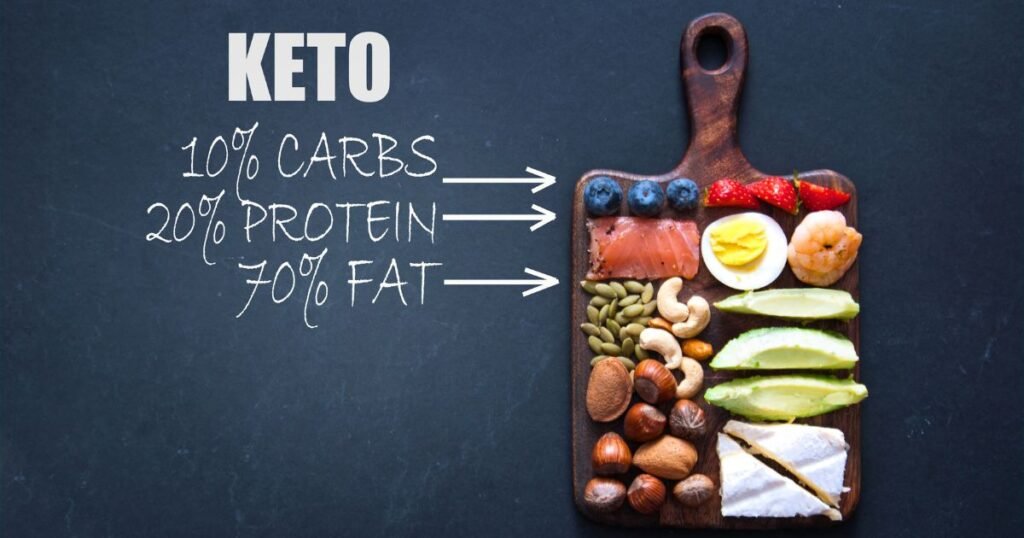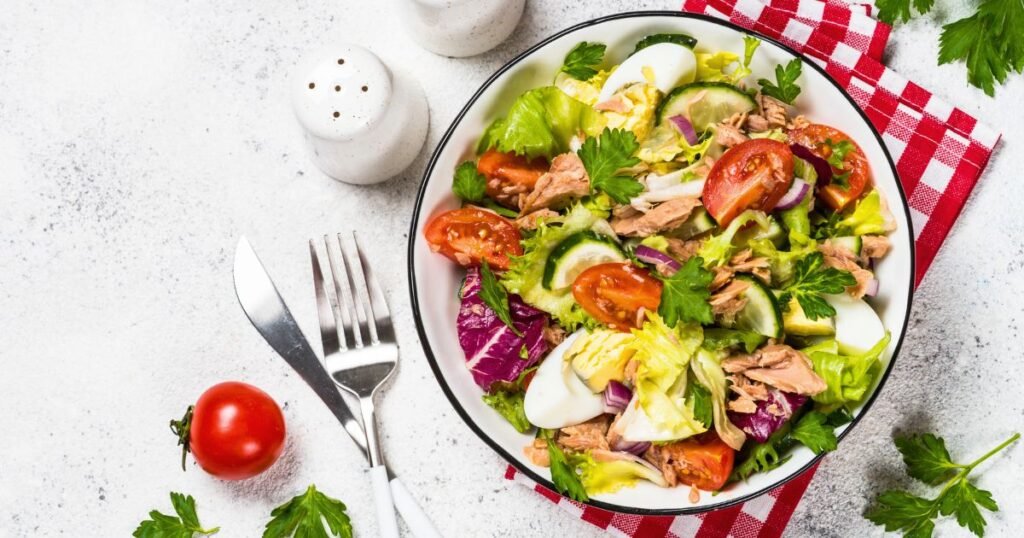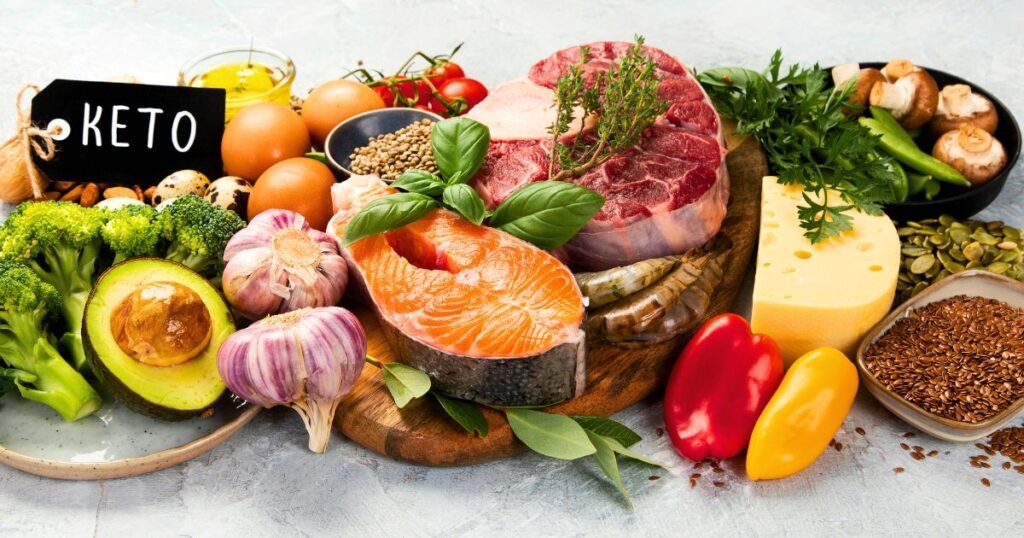Last Updated on 24 February 2024
Are you considering starting a ketogenic diet? The keto diet has gained immense popularity for its potential weight-loss benefits and is considered one of the most effective ways to shed extra pounds. But, like any diet, it requires careful planning and understanding of what foods to include and avoid. In this blog, we will unlock the secrets of the keto food list for beginners, providing you with all the information you need to get started on your keto journey. From understanding the macronutrients in keto to building your keto grocery list, we will cover everything you need to know to make the most of this diet and achieve your weight-loss goals.
- The Keto Diet
- The Essentials of a Keto Food List For Beginners
- Building Your Keto Grocery List
- Selecting the Best Dairy and Eggs for Your Keto Diet
- Navigating the Seafood Section for Keto
- The Importance of Fresh Produce in Keto
- Pantry Must-Haves for the Keto Diet
- Mastering Keto Shopping
- Tailoring Your Keto Diet to Your Lifestyle
- Frequently Asked Questions
The Keto Diet
The keto diet, also known as the ketogenic diet, is a low-carb, high-fat diet that has proven to be effective for weight loss. It works by putting your body into a metabolic state called ketosis, where it begins to burn fat for fuel instead of carbohydrates. This diet emphasizes consuming foods that are high in healthy fats, moderate in protein, and low in carbohydrates. By drastically reducing your intake of carbs and increasing your fat consumption, the keto diet aims to shift your body’s metabolism, resulting in weight loss and other health benefits.
What is the Ketogenic Diet?
The keto diet is a low-carb, high-fat diet that is designed to put your body into a metabolic state called ketosis. This metabolic state is achieved by drastically reducing your carbohydrate intake and increasing your fat intake. By limiting carbs, the keto diet forces your body to use fats for energy, resulting in weight loss. The keto diet is often used as a tool for weight loss, but it also has other potential health benefits, such as improving blood sugar control, reducing inflammation, and increasing energy levels.
Benefits of the Keto Diet for Weight Loss
One of the main benefits of the keto diet is its effectiveness in weight loss. The high fat intake of the diet helps to keep you feeling full and satisfied, reducing cravings and overeating. By reducing your carb intake, you also lower your blood sugar levels, which can help regulate hunger hormones and promote weight loss. Additionally, the keto diet has been shown to increase fat burning and improve insulin sensitivity, both of which are important for weight loss. By following a keto diet, you can accelerate fat loss and reach your weight-loss goals more quickly.
The Essentials of a Keto Food List For Beginners
To successfully follow a keto diet, it is important to understand the essentials of a keto food list. The keto diet focuses on three main macronutrients: fats, proteins, and carbohydrates. While carbs are limited, healthy fats and protein sources play a crucial role in providing energy and nutrients. In addition, low-carb foods are emphasized, as they help to keep blood sugar levels stable and promote fat burning. By including these essential foods in your keto diet, you can optimize your weight-loss journey and achieve better overall health.
Understanding Macronutrients in Keto
Macronutrients play a critical role in the keto diet, and understanding them is essential for creating an effective meal plan. The three primary macronutrients are fats, proteins, and carbohydrates. Fats should make up the majority of your daily calorie intake on a keto diet. The second-largest food group is protein, and the least is carbohydrate. Net carbs have the most significant impact on blood sugar levels and are calculated by subtracting fiber from total carbs. By focusing on healthy fats, high-quality protein sources, and low-carb foods, you can maintain a state of ketosis and optimize weight loss on the ketogenic diet.

Significance of Low-Carb Foods
Low-carb foods are an essential aspect of the keto diet, as they help to keep blood sugar levels stable and support weight loss. When following a keto diet, it is important to monitor your intake of carbs and aim for a specified number of grams of carbs per day. This allows you to stay in a state of ketosis, where your body is burning fat for fuel instead of carbohydrates. By incorporating low-carb foods such as leafy greens, non-starchy vegetables, and low-sugar fruits, you can enjoy a wide variety of foods while still reaching your weight-loss goals.
Building Your Keto Grocery List
Creating a keto grocery list is an essential step in successfully following the keto diet. By stocking your pantry and refrigerator with keto-friendly foods, you set yourself up for success and make it easier to stick to your dietary goals. In this section, we will explore the best keto-friendly protein sources, low-carb vegetables and fruits, healthy fats and oils, dairy and egg options, and seafood choices. By including these foods in your keto grocery list, you can ensure you have a wide variety of options for delicious and satisfying meals.
Keto-friendly Protein Sources
Protein is an important macronutrient in the keto diet, as it helps to keep you feeling full and satisfied. When it comes to selecting protein sources for a keto diet, it is important to choose options that are low in carbs and high in healthy fats. Here are some keto-friendly protein sources to include in your diet:
- Chicken breast: This is a lean source of protein that can be grilled, baked, or sautéed.
- Fatty fish: Fish such as salmon, sardines, and trout are rich in omega-3 fatty acids, which are beneficial for heart health and weight loss.
- Eggs: Egg whites are high in protein, while the yolks provide healthy fats and essential vitamins.
- Grass-fed beef: This type of beef is higher in omega-3 fatty acids and lower in inflammatory fats compared to conventional beef.
- Greek yogurt: A good source of protein and healthy fats, Greek yogurt can be enjoyed plain or with added low-carb toppings.
Low-Carb Vegetables and Fruits
When following a keto diet, it is important to choose low-carb vegetables and fruits to stay within your carb limit while still getting essential vitamins and minerals. Here are some low-carb options to include in your keto meal plan:
- Bell peppers: These colorful peppers are low in carbs and high in vitamins, making them a great addition to keto recipes.
- Leafy greens: Spinach, kale, and arugula are low in carbs and high in nutrients like vitamin C and vitamin K.
- Avocado oil: This healthy fat is a great choice for cooking and dressing, as it provides a good balance of monounsaturated fats.
- Broccoli: Low in net carbs, it is high in fiber, vitamins, and minerals, making it a nutritious choice for keto meals.
Healthy Fats and Oils
Fat is a cornerstone of the keto diet, as it serves as a major source of energy. While it may seem counterintuitive, healthy fats are an essential part of a well-formulated keto diet. Including healthy fats and oils in your meals helps to keep you feeling satisfied, provides essential fatty acids, and supports weight loss. Here are some healthy fats and oils to include in your keto diet:
- Olive oil: A staple of Mediterranean cuisine, olive oil is high in monounsaturated fats, which have been linked to improved heart health.
- Coconut oil: This unique oil is rich in medium-chain triglycerides (MCTs), provides quick energy, and has been shown to support weight loss.
- Avocado: This fruit is high in healthy fats and fiber, making it a keto-friendly choice for salads, spreads, and smoothies.
Selecting the Best Dairy and Eggs for Your Keto Diet
Dairy products and eggs are excellent sources of protein and healthy fats, making them a valuable addition to a keto diet. In this section, we will explore the best keto-friendly dairy options, such as Greek yogurt, sour cream, and cheese, as well as the role of eggs in a ketogenic diet. By choosing the right dairy and egg options, you can enjoy delicious meals while still staying within your carb limit and achieving your weight loss goals.
Choosing Keto-friendly Dairy Products
When it comes to incorporating dairy products into a keto diet, it is important to choose options that are low in carbs and high in healthy fats. Here are some keto-friendly dairy options to include in your meal plan:
- Greek yogurt: Plain Greek yogurt is high in protein and low in carbs. It is a versatile option for keto dieters.
- Sour cream: This product has a creamy texture and a tangy flavor. It can be used as a topping or ingredient in keto recipes.
- Cheese: Hard and soft cheeses, such as cheddar, feta, and cream cheese, are low in carbs and high in fat, making them an excellent choice for keto dieters.
The Role of Eggs in Keto
Eggs are a staple food in the keto diet, as they are rich in protein and healthy fats and low in carbs. They also contain essential vitamins and minerals, making them an excellent choice for keto dieters. Eggs can be enjoyed in a variety of ways, from scrambled to boiled, and can be incorporated into many keto recipes. By including eggs in your keto meal plan, you can ensure you are getting the nutrients you need while still staying in ketosis.
Navigating the Seafood Section for Keto
Seafood is a great option for keto dieters, as it is low in carbs and high in healthy fats, particularly omega-3 fatty acids. \By including seafood in your keto diet, you can enjoy a delicious variety of options while reaping the numerous health benefits it offers.
Best Seafood Choices for Keto
Seafood is an excellent source of high-quality protein and healthy fats, making it a valuable addition to a keto diet. Here are some of the best seafood choices for keto:
- Salmon: Rich in omega-3 fatty acids, salmon provides heart-healthy fats and supports brain function.
- Sardines: These small fish are packed with omega-3 fatty acids, calcium, and vitamin D.
- Trout: With its delicate flavor and high omega-3 content, trout is a nutritious choice for keto dieters.
- Shrimp: Low in carbs and high in protein, shrimp is a versatile seafood option for keto meals.
The Importance of Fresh Produce in Keto
Fresh produce, including leafy greens, low-sugar fruits, and non-starchy vegetables, is an important part of a keto diet. In this section, we will explore the significance of incorporating fresh produce into your meals, as well as the benefits of specific nutrients found in these foods. By including fresh produce in your keto diet, you can ensure you are getting essential vitamins, minerals, and antioxidants while still staying in ketosis.
Incorporating Leafy Greens
Leafy greens, such as spinach, kale, and arugula, are low in carbs and high in vitamins and minerals, making them an excellent choice for keto dieters. Here are some reasons why leafy greens are important on a keto diet:
- Vitamin C: Leafy greens are high in vitamin C, which supports immune function and helps your body absorb iron.
- Vitamin K: Leafy greens are also rich in vitamin K, which is necessary for blood clotting and bone health.
- Low in net carbs: Leafy greens are low in net carbs, meaning their carb content is low, and most of their carbs come from fiber, which is not fully digested.
Low-Sugar Fruits that Fit into Keto
While fruit is generally high in sugar, some low-sugar fruit options can be included in a keto diet in moderation. Here are some low-sugar fruits that fit into a keto diet:
- Berries: Berries, such as strawberries, blueberries, and raspberries, are low in sugar and high in fiber, making them a great choice for keto dieters.
- Avocado: Although not sweet, avocado is high in healthy fats and low in net carbs, making it a versatile fruit for keto recipes.
- Lemons and limes: These citrus fruits are low in sugar and can add flavor to keto dishes and beverages without adding many carbs.
Pantry Must-Haves for the Keto Diet
Stocking your pantry with keto-friendly condiments, sweeteners, nuts, seeds, and other essentials is crucial for staying on track with your keto diet. In this section, we will explore the must-have pantry items for keto dieters, including essential keto-friendly condiments, keto-approved sweeteners, nuts, and seeds that can be enjoyed in moderation. By having these items on hand, you can easily prepare keto-friendly meals and snacks without feeling deprived.

Condiments are a great way to enhance the flavor of keto meals while keeping carbs low. Here are some essential keto-friendly condiments to keep in your pantry:
- Ranch dressing: Opt for a ranch dressing made with keto-friendly ingredients, such as avocado oil or olive oil.
- Mustard: Yellow mustard, Dijon mustard, and stone-ground mustard are all low in carbs and can add flavor to keto dishes.
- Hot sauce: Most hot sauces are low in carbs and can spice up your meals without adding many calories.
- Sugar-free ketchup: Look for a sugar-free ketchup option made with keto-approved sweeteners, such as stevia or erythritol.
- Mayonnaise: Choose a high-quality mayonnaise made with healthy fats, such as avocado oil or olive oil.
Keto-approved Sweeteners
When following a keto diet, it’s important to choose sweeteners that won’t spike your blood sugar levels. Here are some keto-approved sweeteners to consider:
- Stevia: A natural, calorie-free sweetener derived from the stevia plant.
- Erythritol: A sugar alcohol that is low in carbs and has a minimal impact on blood sugar levels.
- Monk fruit extract: A natural sweetener derived from the monk fruit that has no carbs or calories.
- Allulose: A low-calorie sugar that tastes like regular sugar but has a minimal impact on blood sugar levels.
- Xylitol: A sugar alcohol that is low in carbs and has a minimal effect on blood sugar levels.
Nuts and Seeds to Stock Up On
Nuts and seeds are an excellent source of healthy fats and provide essential nutrients for keto dieters. Here are some nuts and seeds to consider stocking up on:
- Macadamia nuts: These nuts are high in healthy fats and low in net carbs, making them an excellent choice for keto.
- Chia seeds: These tiny seeds are packed with fiber, protein, and healthy fats, making them a nutritious option for keto dieters.
- Almonds: Almonds are high in healthy fats, fiber, and protein, making them a satisfying snack for keto dieters.
- Walnuts: Walnuts are rich in omega-3 fatty acids, making them a heart-healthy choice for keto dieters.
- Pumpkin seeds: These seeds are high in healthy fats, protein, and important minerals like magnesium and zinc, making them a great addition to a keto diet.
Mastering Keto Shopping
Going grocery shopping for your keto diet can be overwhelming, especially if you are new to the lifestyle. In this section, we will provide tips for efficient keto shopping, including how to navigate the grocery store, read nutrition labels, and avoid common mistakes.
Shopping Tips for Keto Beginners
Shopping for keto begins with creating a keto shopping list and being prepared before entering the grocery store. Here are some tips to make your keto shopping experience more efficient:
- Plan meals: This allows you to create a specific keto shopping list and avoid wandering around the grocery store.
- Prioritize perimeter shopping: The perimeter of the grocery store is typically where you will find fresh produce, meats, and dairy, which are the foundation of a keto diet.
- Focus on whole foods: Avoid processed foods that often contain hidden carbs, sugar, and unhealthy fats.
- Read nutrition labels: Look for total carbs, net carbs, and healthy sources of fat and protein when selecting keto foods.
- Avoid impulse purchases: Stick to your keto shopping list to prevent purchasing high-carb foods that may derail your diet plan.
Common Mistakes to Avoid While Shopping for Keto
When shopping for keto foods, it’s important to be mindful of common mistakes that can hinder your progress. Here are some mistakes to avoid:
- Not checking nutrition labels: Always read nutrition labels to check for hidden carbs, sugar, and unhealthy fats that may sabotage your keto diet.
- Forgetting your beginner-friendly keto food list: Having a list will help you stay focused and avoid purchasing high-carb foods.
- Falling for marketing gimmicks: Many products are labeled as “keto” or “low carb” but still contain hidden sugars or unhealthy fats, so be sure to check the nutrition labels for yourself.
- Ignoring serving sizes: Even keto-friendly foods need to be enjoyed in moderation, so pay attention to portion sizes and avoid overindulging.
- Neglecting a meal plan: Without a meal plan, you may be tempted to reach for convenience foods or high-carb options. Plan to ensure you have the right foods on hand for each meal.
Tailoring Your Keto Diet to Your Lifestyle
Tailoring your keto diet to your lifestyle is crucial for long-term success. In this section, we will explore how to adapt keto to a busy schedule, make keto work for the whole family, and make keto a sustainable lifestyle choice. By finding ways to make keto fit seamlessly into your daily life, you can achieve your weight loss and health goals without sacrificing your lifestyle.
Adapting Keto to a Busy Schedule
Maintaining a keto diet while juggling a busy schedule may seem challenging, but with a few adjustments, you can make it work. Here are some tips for adapting keto to a busy schedule:
- Follow a keto meal plan: Planning meals in advance saves time and ensures you have keto-friendly options on hand.
- Prepare meals in advance: Batch-cooking keto meals on weekends or your days off can save time during the week.
- Opt for quick breakfast options: Prepare quick breakfast options, such as keto smoothies, chia seed pudding, or egg muffins, for busy mornings.
Making Keto Work for the Whole Family
The keto diet can be tailored to accommodate the whole family, even if not everyone is following it. Here are some tips for making keto work for the whole family:
- Create customizable meals: Prepare meals that can be customized to accommodate individual preferences, such as taco nights with keto-friendly shells and non-keto options.
- Introduce keto recipes slowly: Gradually incorporate keto recipes into your family meals, starting with simpler options that everyone can enjoy.
- Make keto meals appealing to kids: Use creative presentations, like shaping eggs into fun shapes or using low-carb pizza crusts, to make keto meals more appealing to children.
- Educate family members about the benefits of keto: Explaining the health benefits of the keto diet can help your family understand why you have chosen this dietary approach.
- Involve the whole family in meal planning and grocery shopping: Encourage family members to participate in meal planning and grocery shopping to ensure keto-friendly options are available for everyone.
Embarking on a keto diet can lead to transformative changes in your health and well-being. By following a keto meal plan and staying consistent, you can achieve your weight loss goals, improve blood sugar control, increase energy levels, and experience numerous other health benefits. The keto lifestyle is not just about weight loss; it is about fueling your body with healthy fats, moderate protein, and low carbs to optimize overall health. If you’re ready to transform your health, the keto diet may be the perfect fit for you. If you are ready to transform your health with keto, explore the answers to frequently asked questions about the ketogenic diet.









